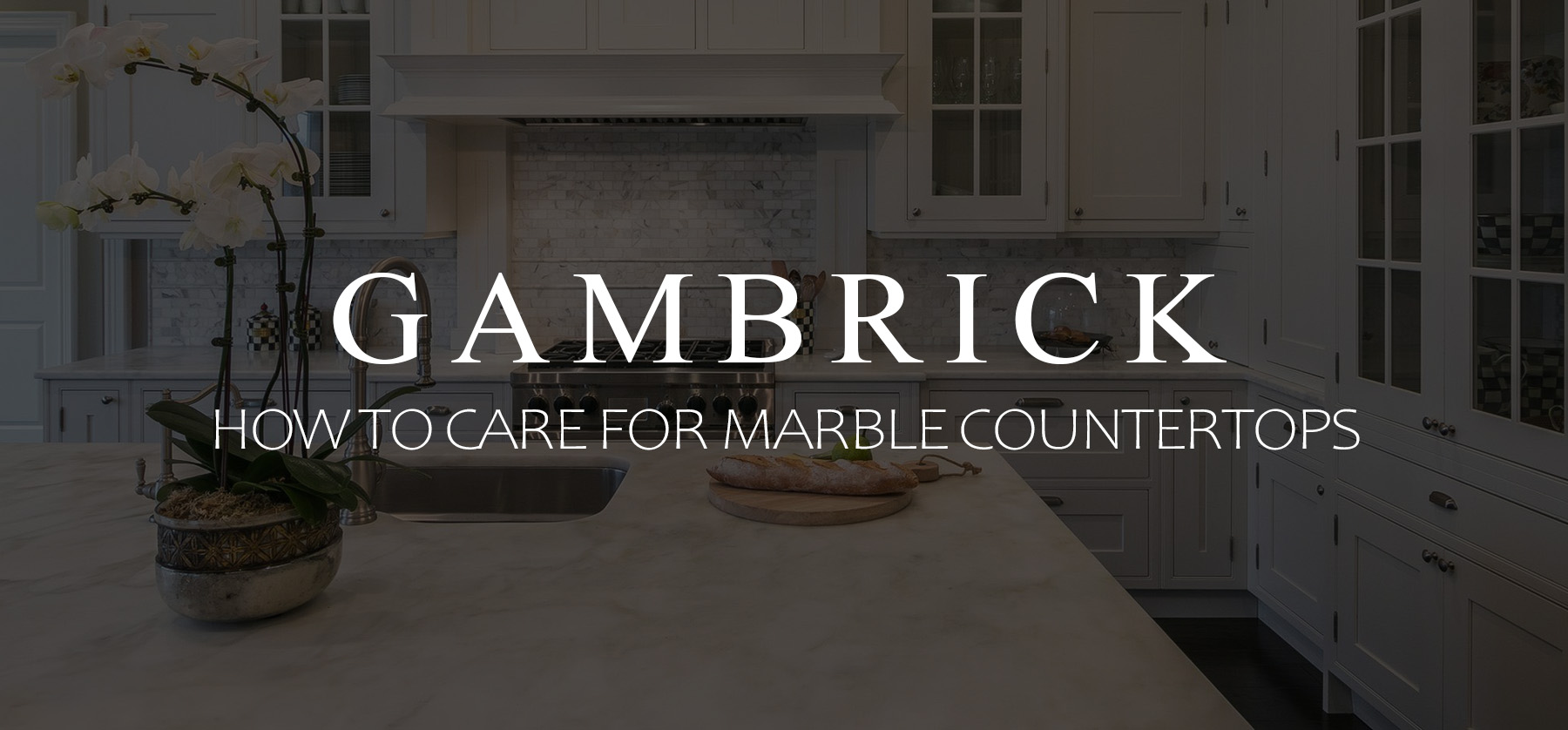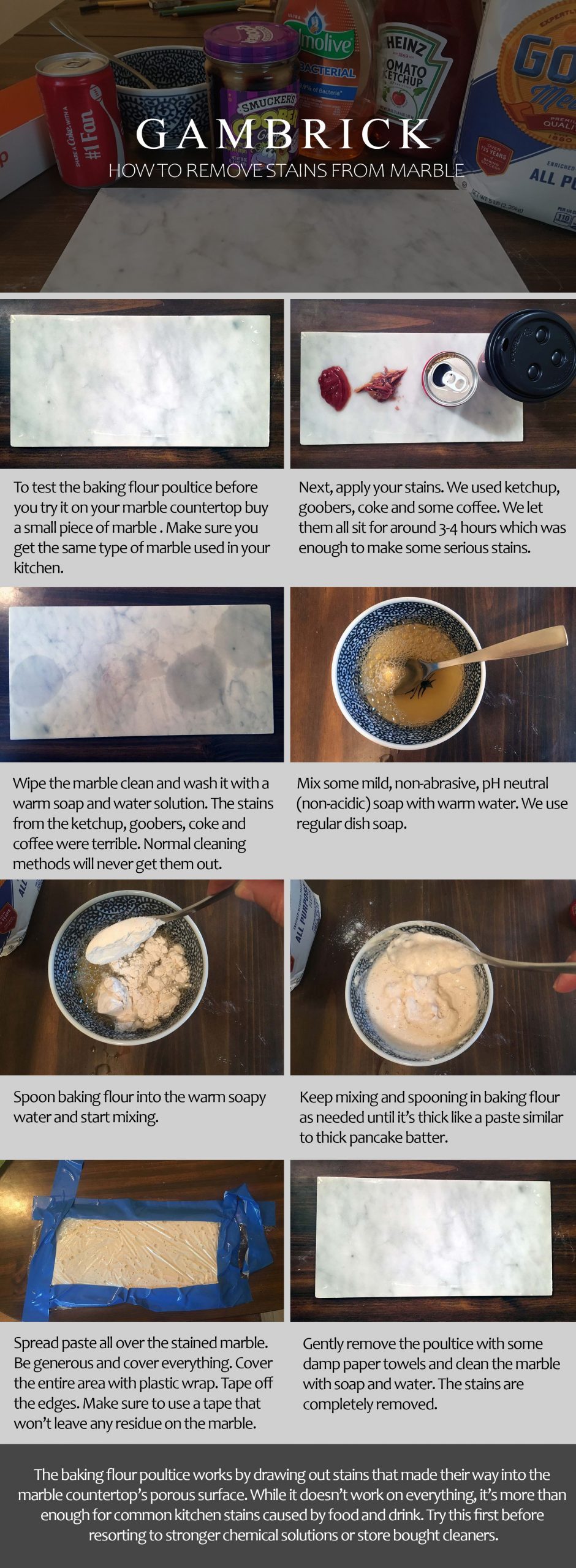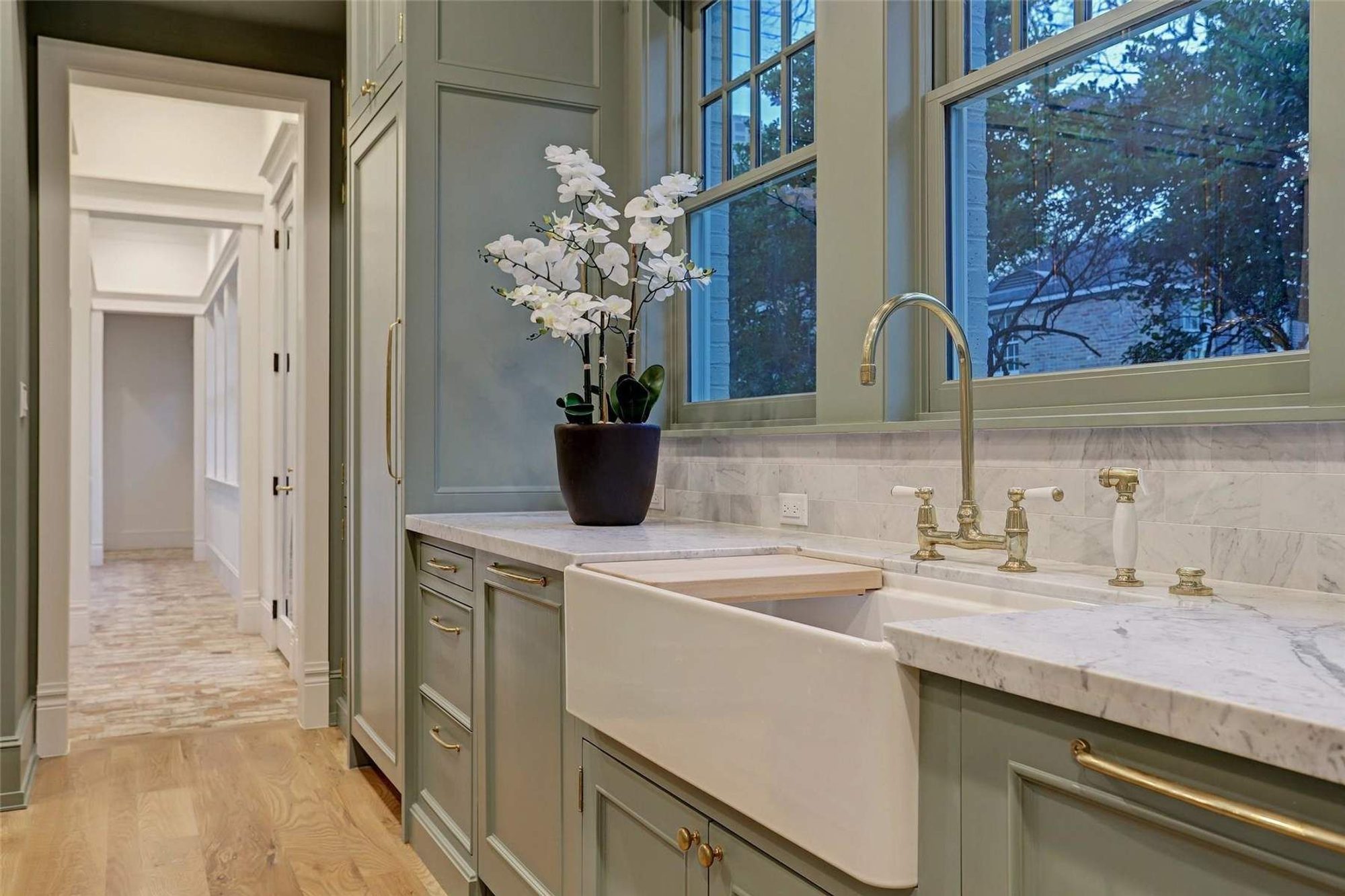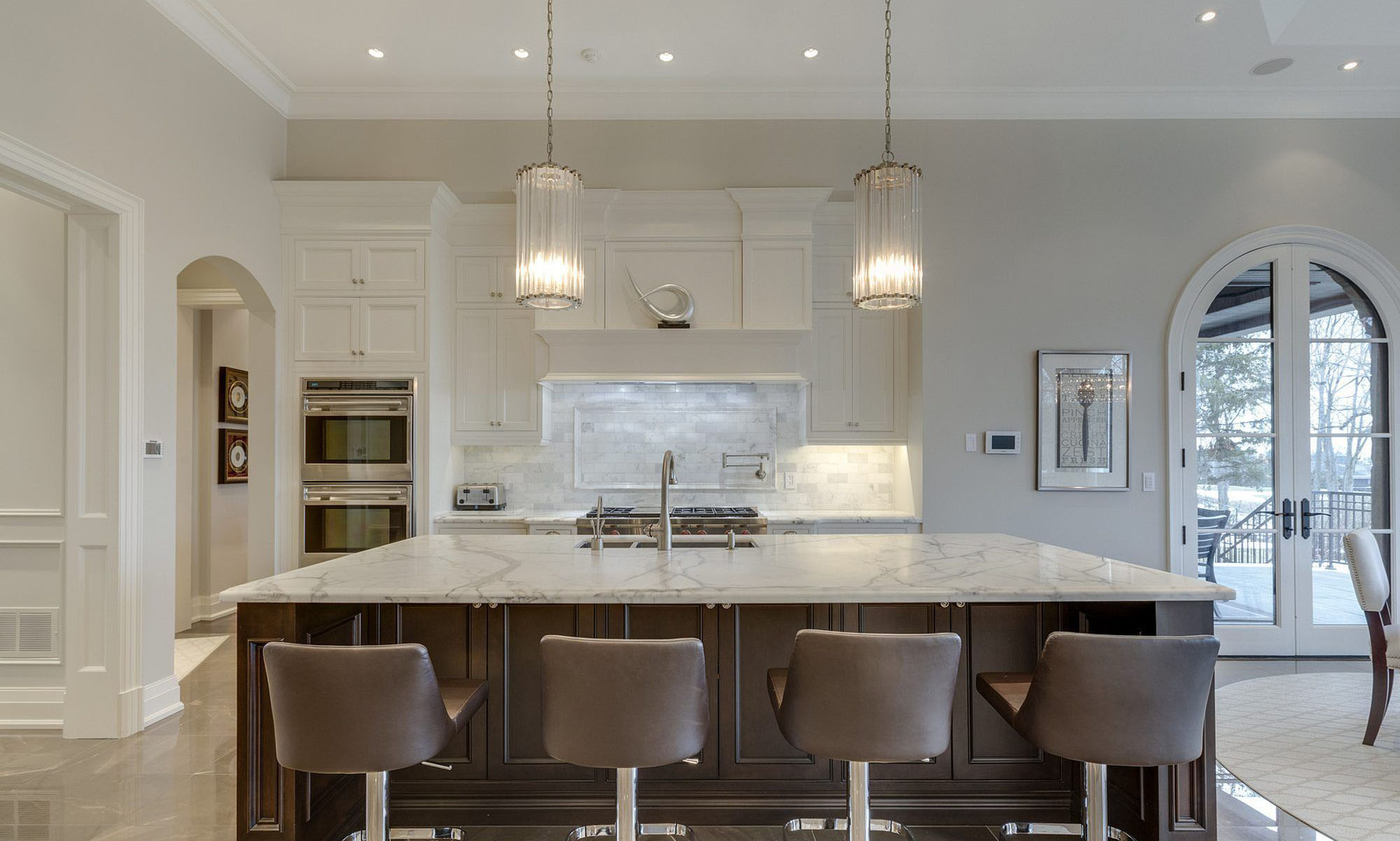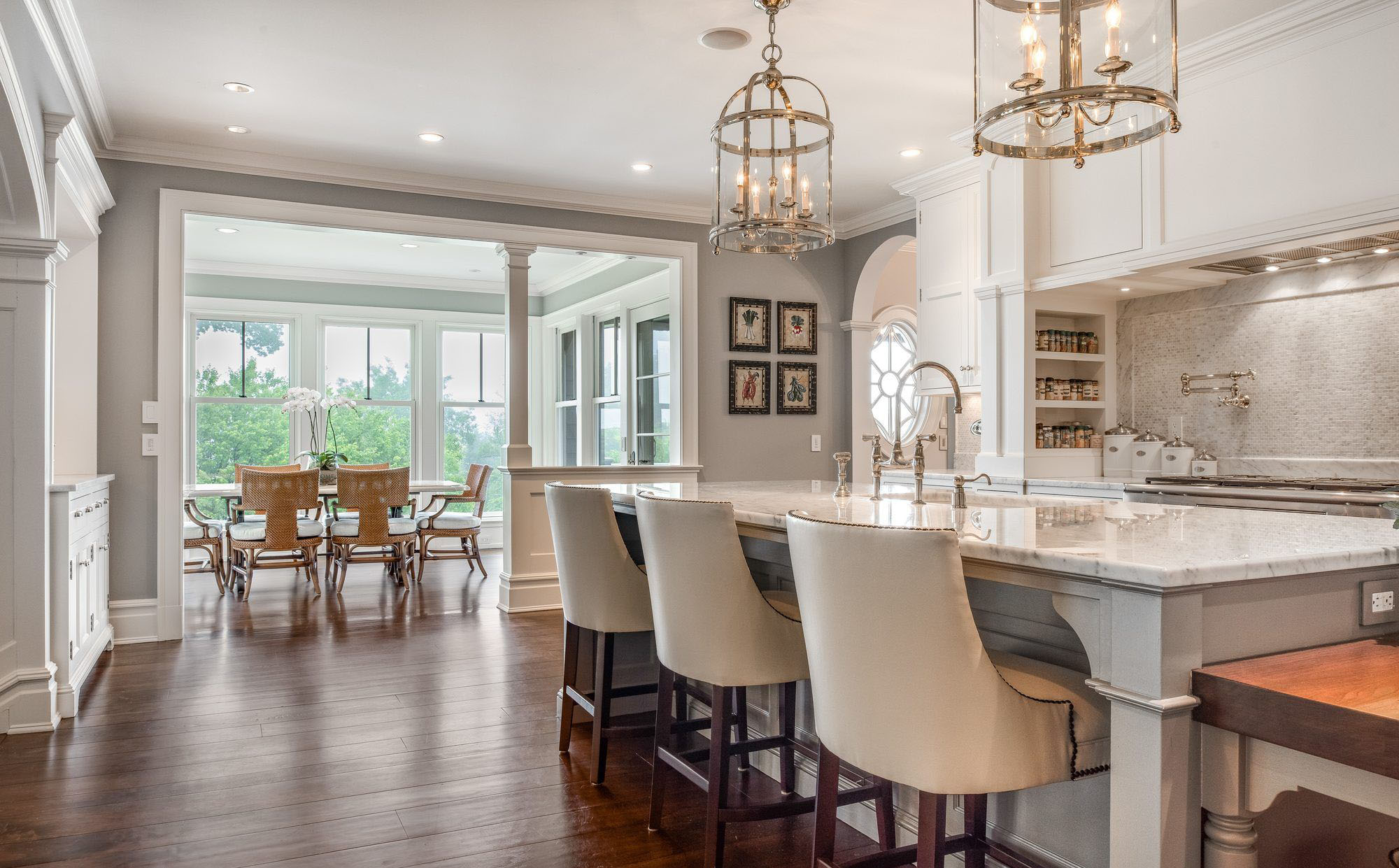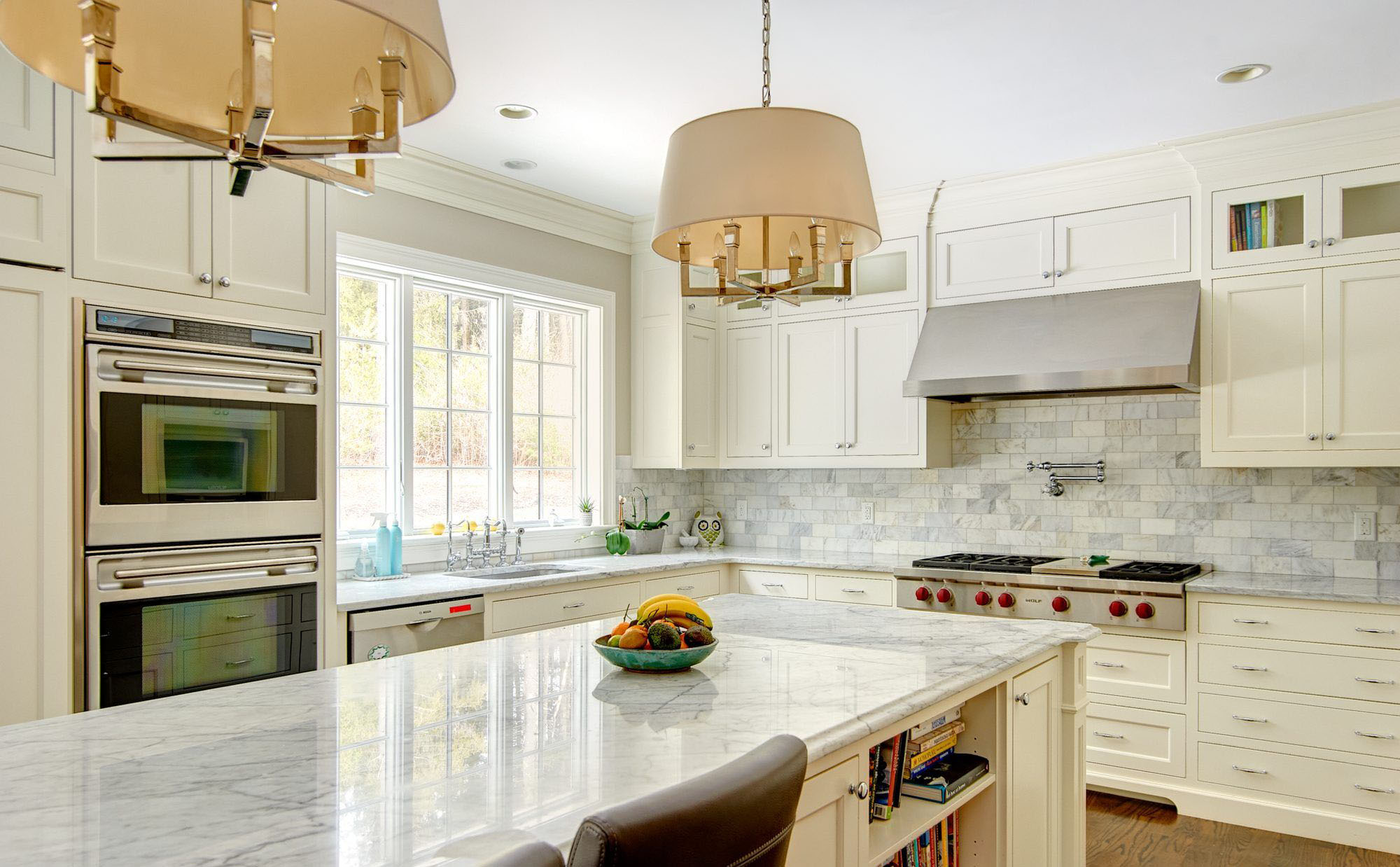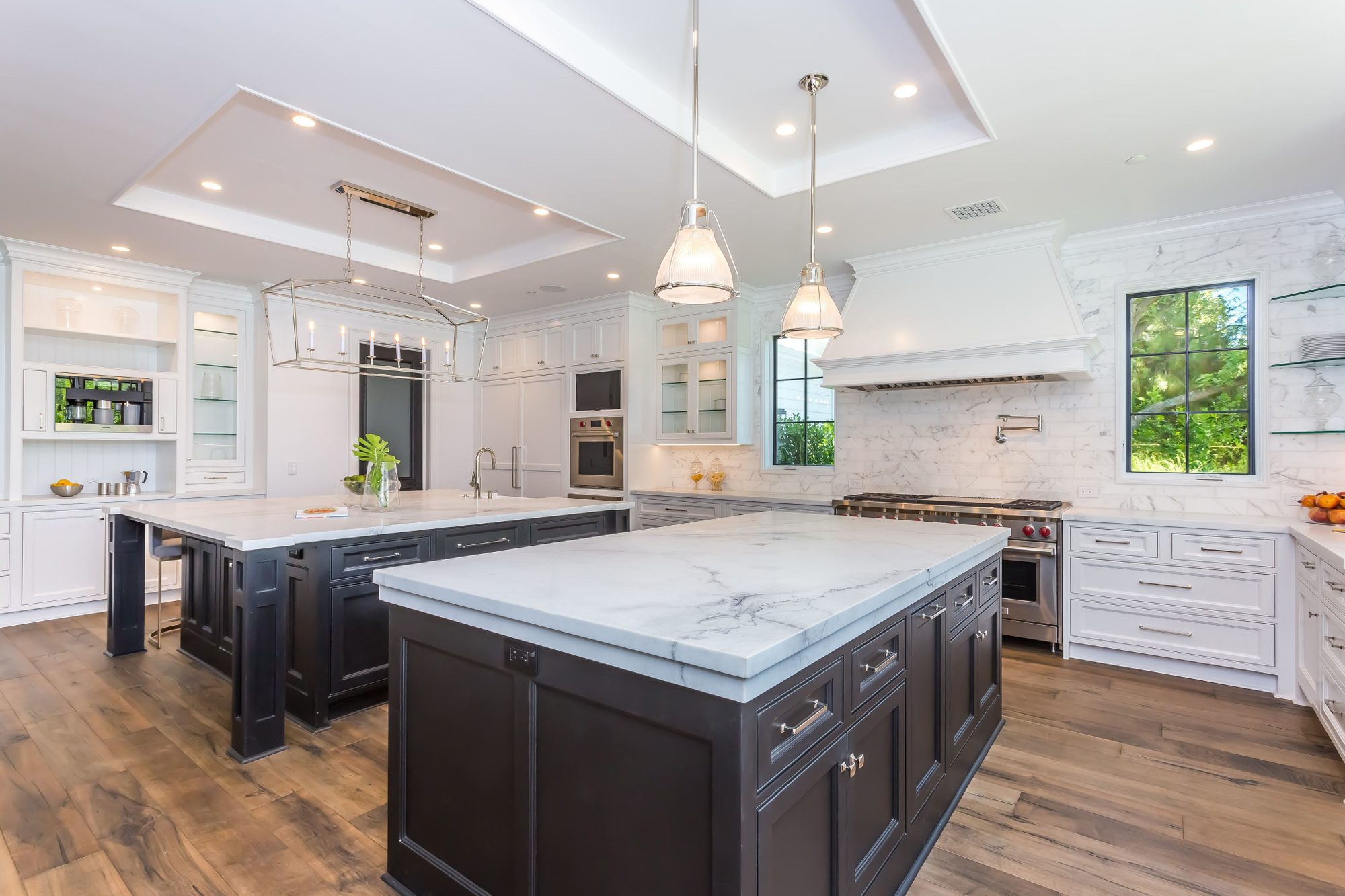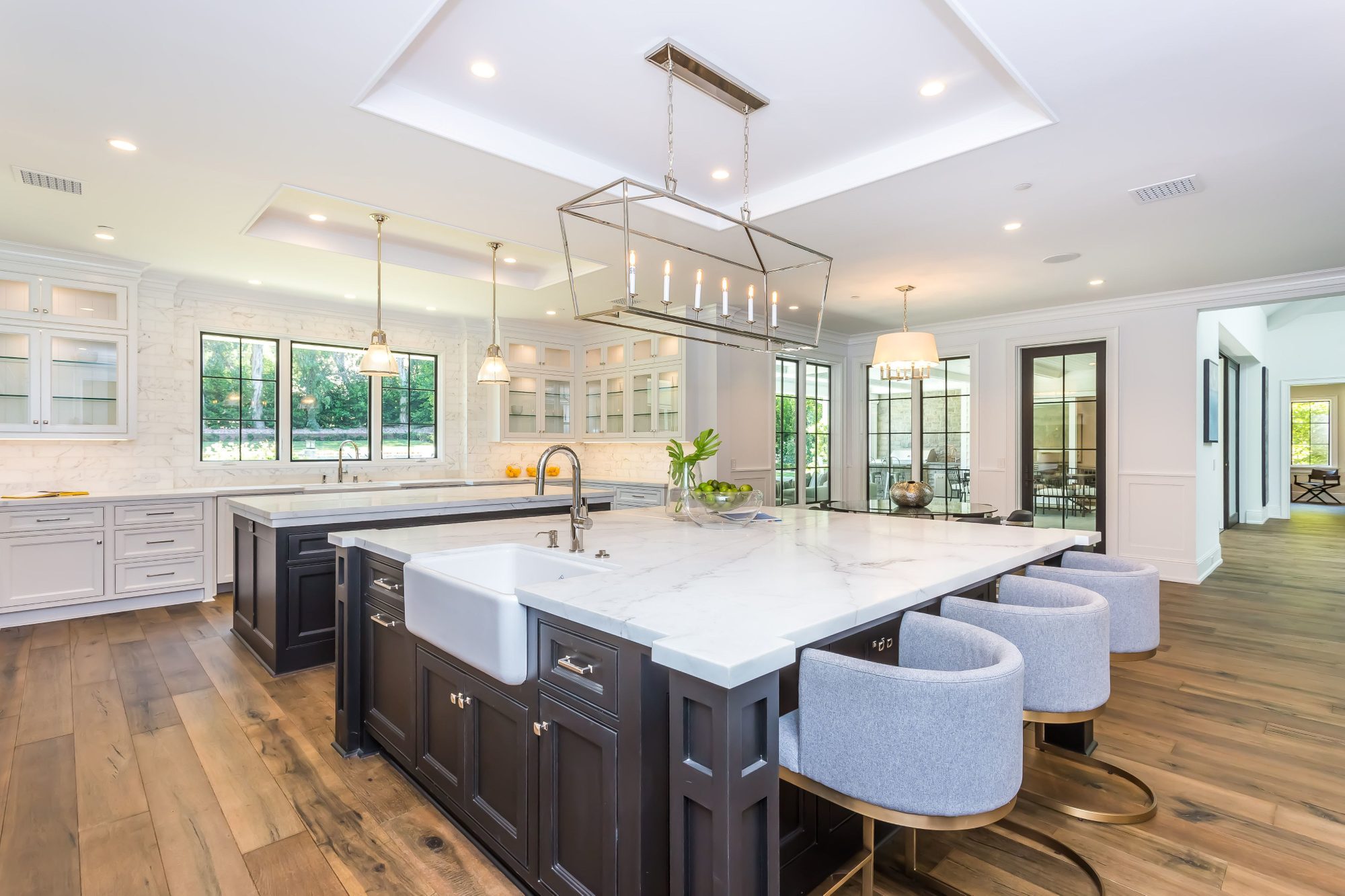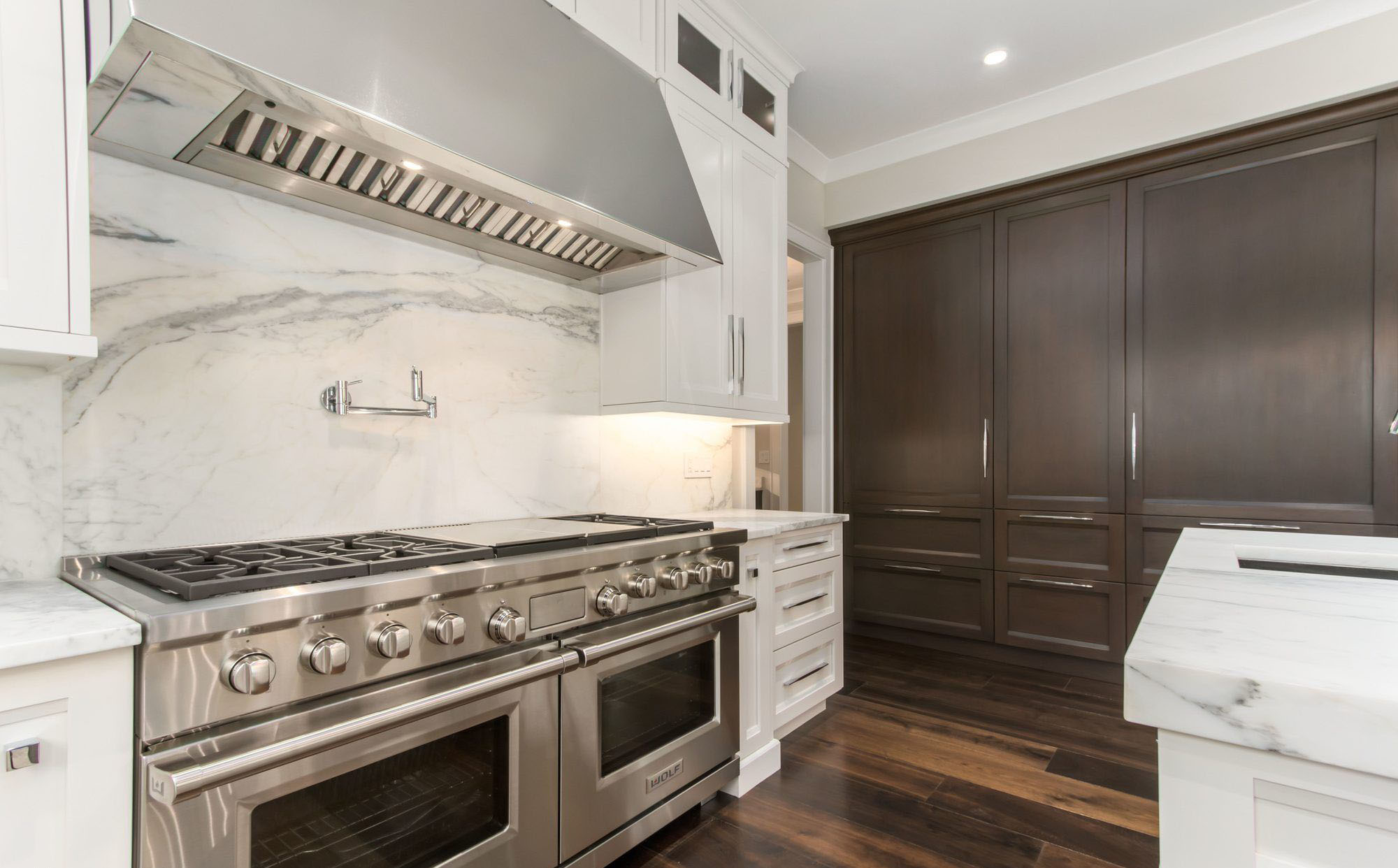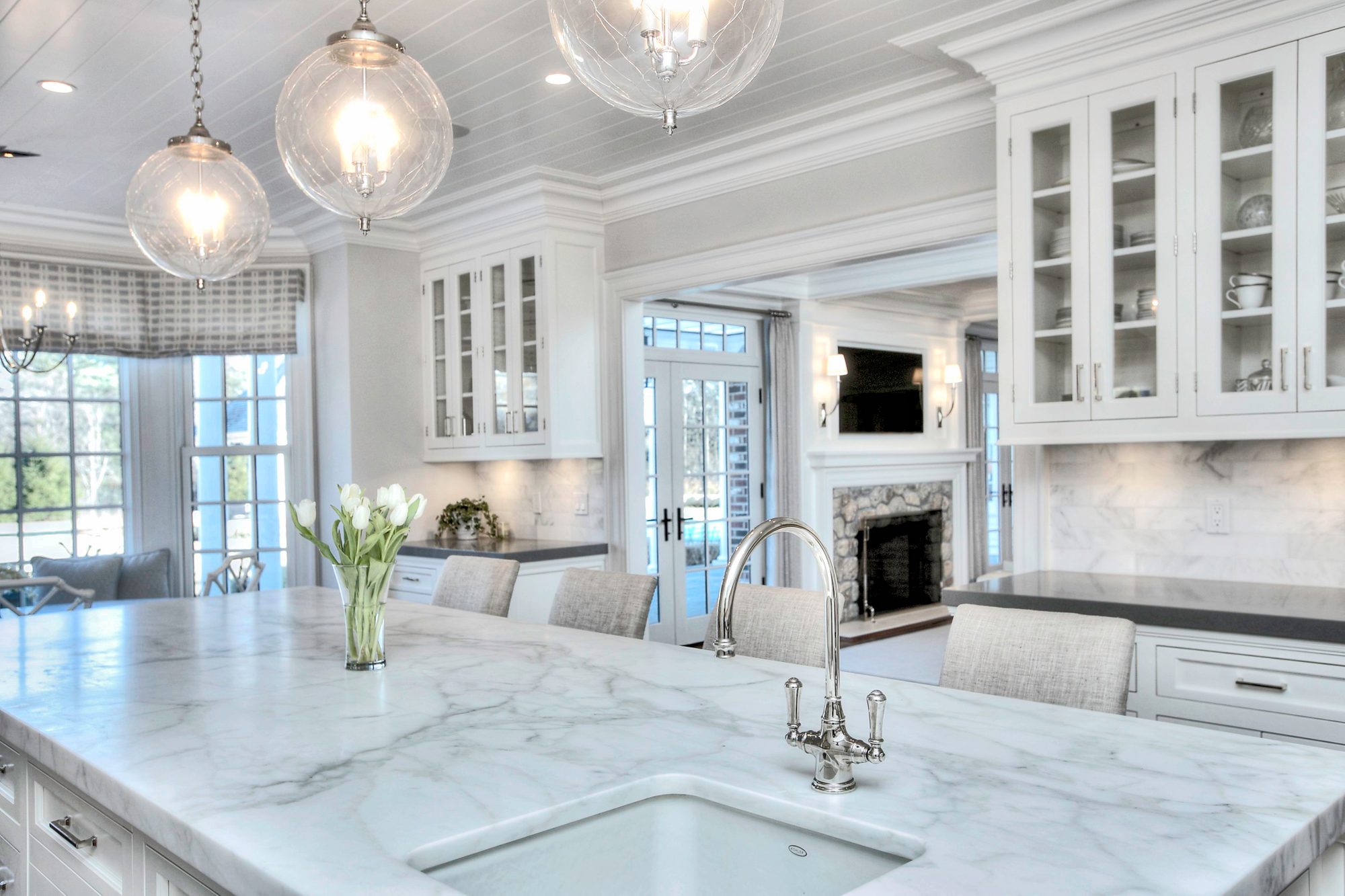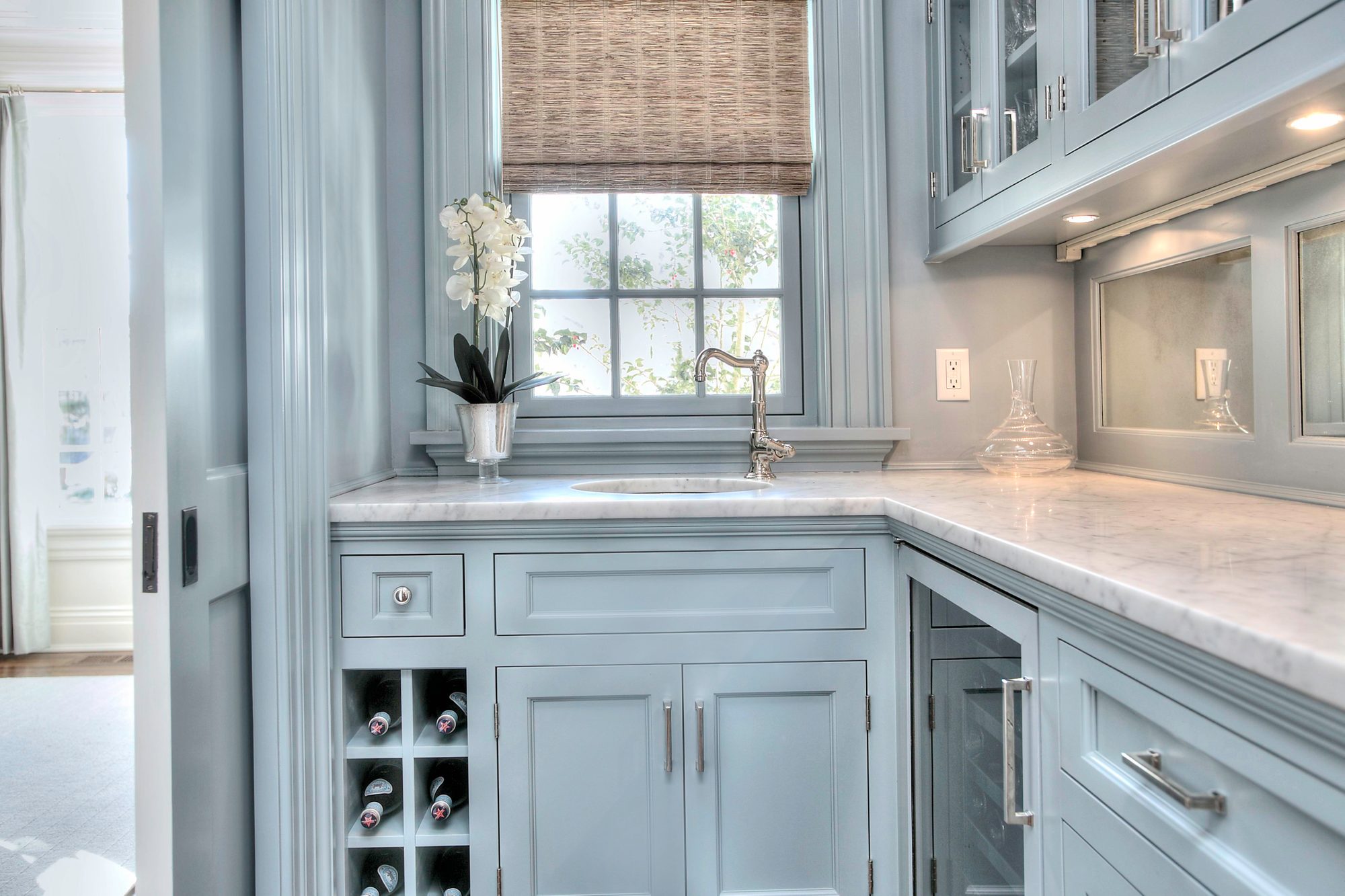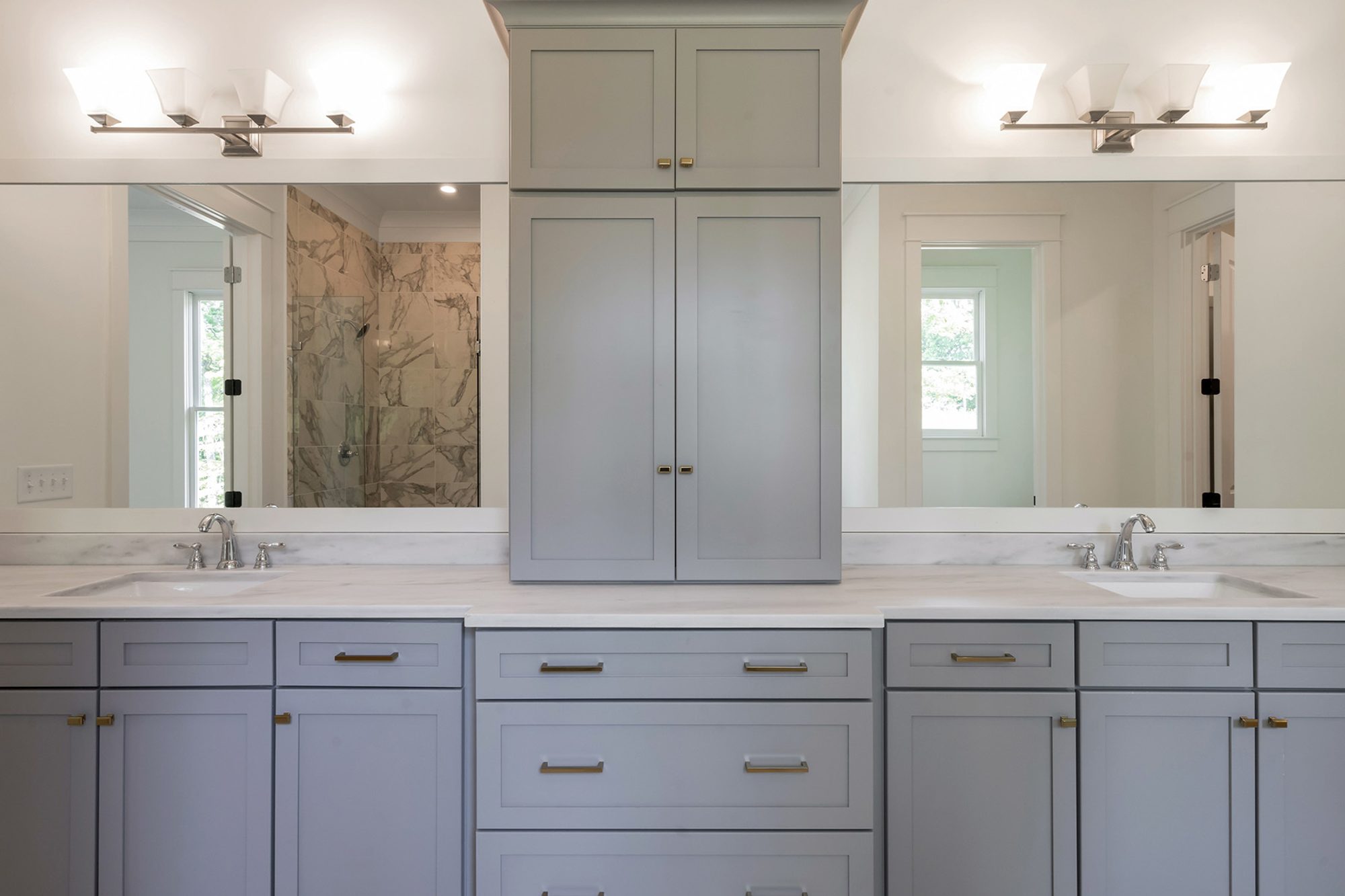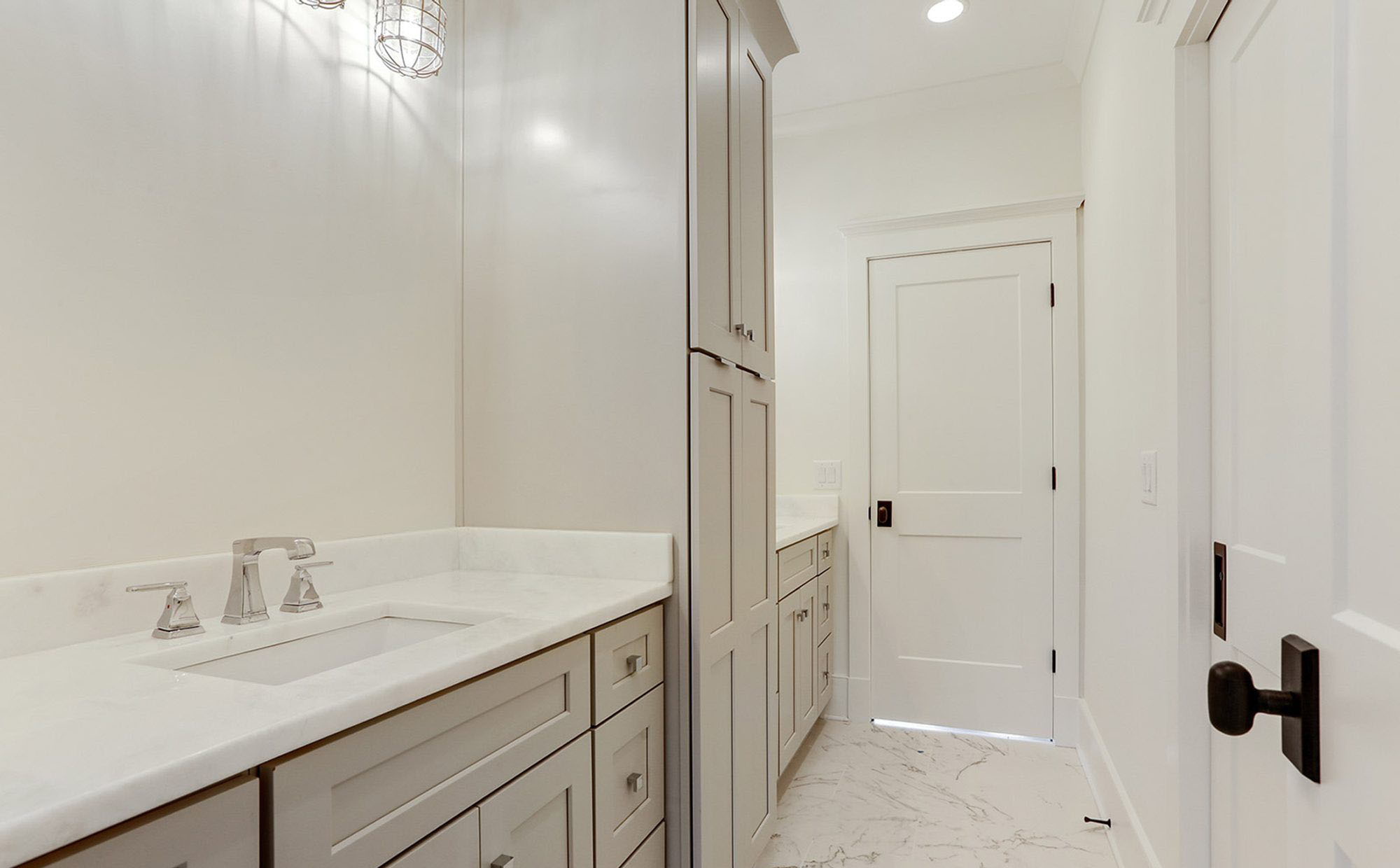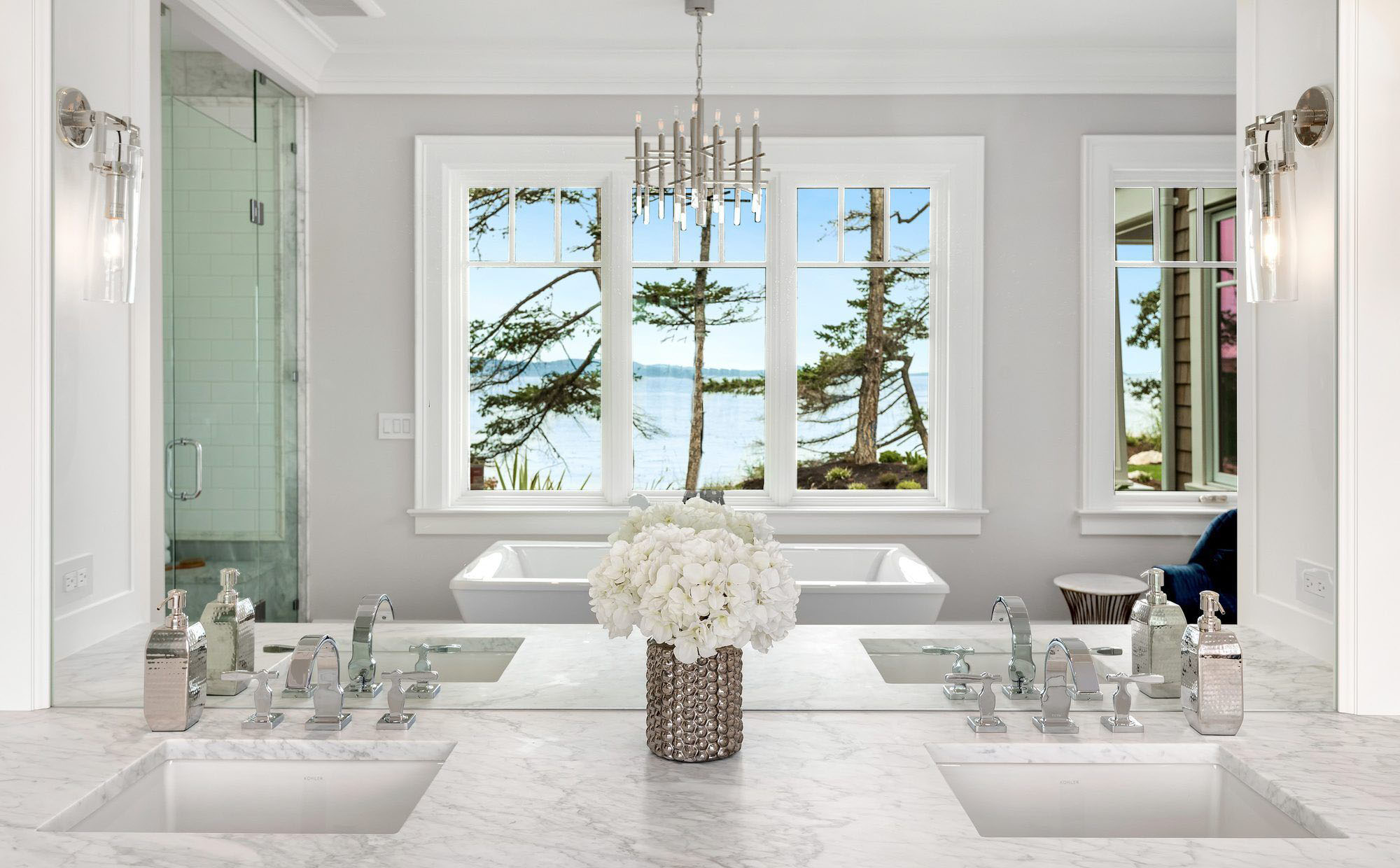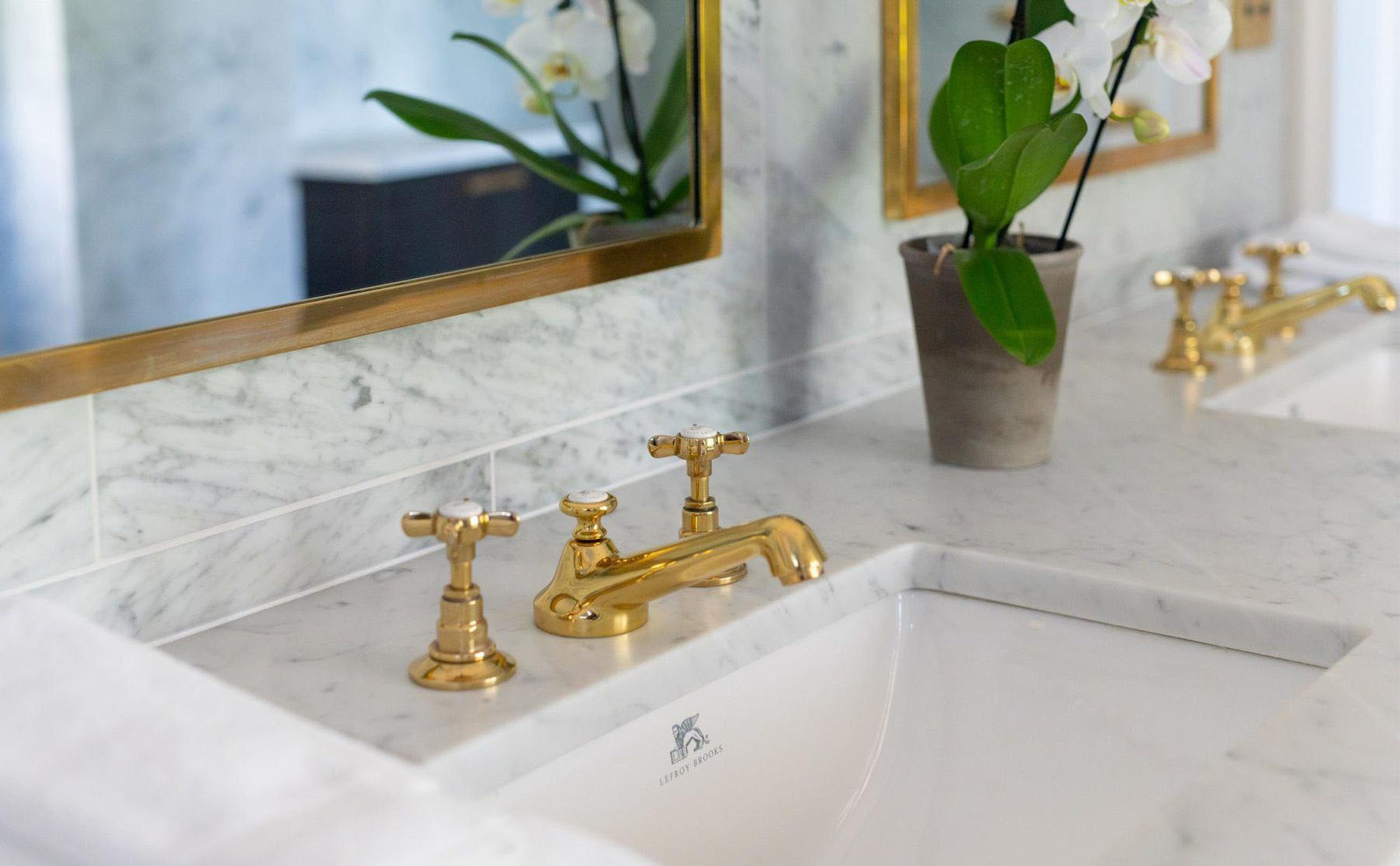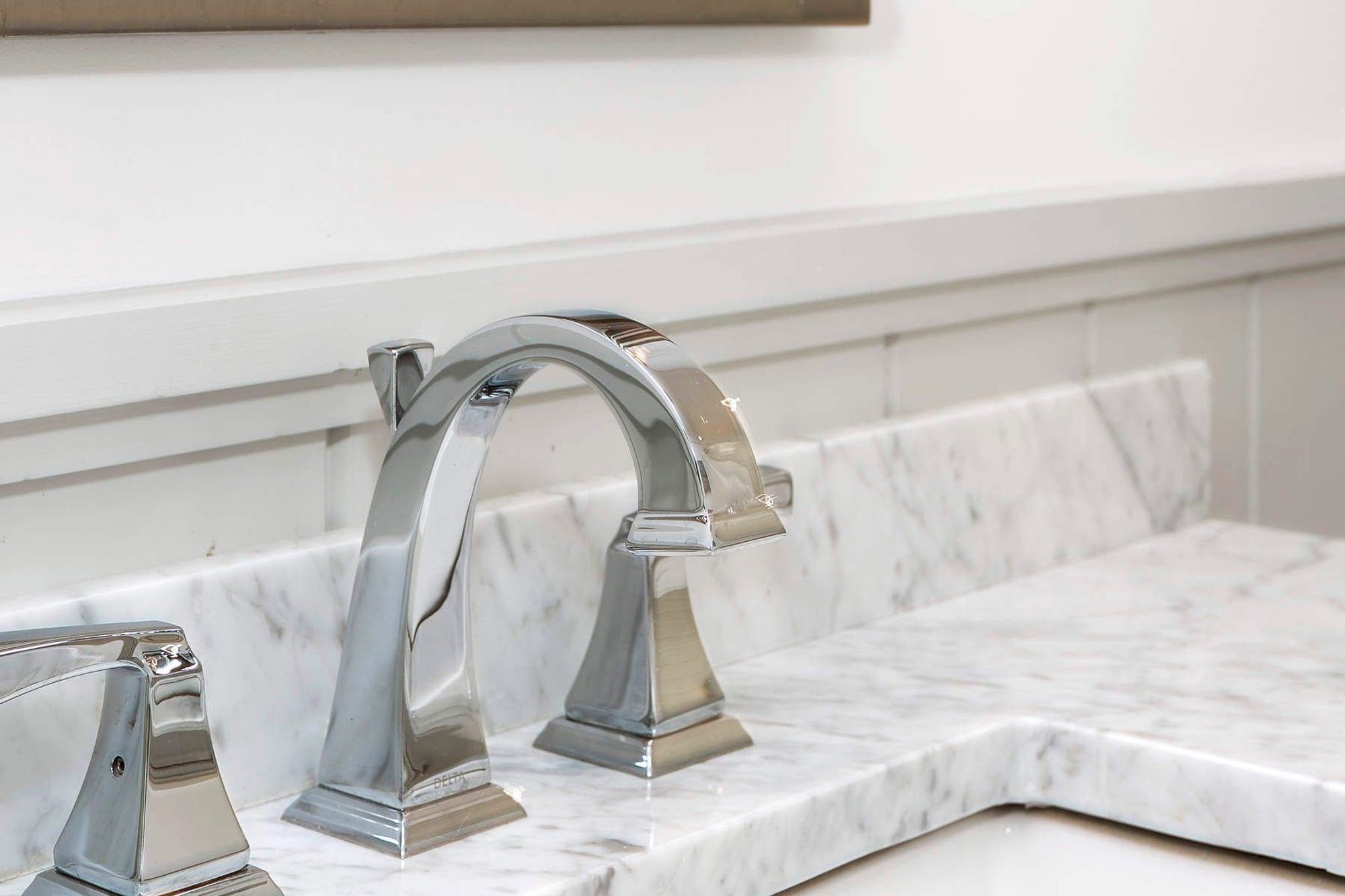How To Care For Marble Countertops
Marble is a fabulous material to use on your countertops in the kitchen, bathroom, laundry or even by the fireplace. But it’s a delicate stone that’s easily damaged or stained so learning the proper way how to care for marble countertops is very important.
There’s no doubting how beautiful a slab of marble can be. But there’s no getting away from how soft it is compared to other countertops materials. It’s easily scratched, chipped, broken, etched and stained. In some locations that don’t see much traffic like your master bath or on a shelf somewhere that may not be an issue. But in the kitchen that can spell disaster. And marble isn’t cheap. Especially the huge slab required to cover even an average size center island. Learning how to care for marble countertops if you plan on using them in your kitchen is crucial. That not only means the day to day care but also how to clean them should something damage or stain them. It’s not actually that hard but it does take a bit more effort than with granite or quartz.
Below is our guide on how to care for marble countertops. It covers everything from day to day cleaning, sealing, and removing stains and etching.
What Makes Marble Harder To Care For?
There are three main reasons that make marble harder to care for than other types of countertop stones.
- Soft. Marble is a soft stone that’s easy to scratch. You may also notice more pitting, cracks, and even dulling of the shine.
- Porous. Marble is also porous which makes it very easy to stain. We built a new home last year with a huge marble slab covering the island. One of the workers left a soda can on the counter by accident and an hour later the marble was stained. We were able to get it out with a simple poultice solution but if we couldn’t it was a $3500 mistake. Dirt, bacteria, and coloring from liquids can quickly seep into the stone leaving stains.
- Calcium. Marble has a high calcium carbonate makeup which makes it very easy to etch from acids. And we’re talking about every day safe acids like what’s found in a soda, juice, tomatoes, an orange or lemon. There are mild acids found in all sorts of foods and they can all etch the marble.
Caring For Marble Takes Effort
A marble countertop in the kitchen where cooking and eating happens is hard to keep pristine. But you can do it if you stay on top of things and make sure to always wipe up anything that spills as soon as it happens. Don’t ever let anything wet sit on the counter, not even water. The substances in the water can result in water spots. That’s how delicate marble is.
If you decide to let a few things go then your not alone. Some clients actually like a bit of wear and tear on the marble. It becomes a part of the beauty of having natural stone. Over years of use the marble can acquire a patina that brings character a brand new stone doesn’t offer. Others think this type of wear makes the marble look dirty. It’s entirely a personal choice that’s up to you. Personally I don’t like any coloring at all on my marble and want it to look brand. So I constantly care for it and avoid these issues.
Either way there are some things you can do to protect and preserve it.
How To Maintain Marble Countertops
Choosing marble for your home is an easy choice. It’s beautiful and has a rich quality that no other stone can match.
Make sure to select the slab yourself. Many clients choose a color from a small sample or photo not realizing that each slab is totally unique. The veining is natural and varies in design and color quite a bit. But all marble has the same durability and maintenance issues which don’t change no matter what the slab looks like.
There’s just no getting around the stone’s porous nature which makes it prone to etching and staining. Honed marble, which has a matte finish, hides the small imperfections better than polished but generally isn’t considered as nice a finish. Although that could be a benefit in the kitchen.
Personally I recommend going all the way with countertop marble. I buy the nicest slab I can find and polish it. I accept the maintenance requirements that come with maintaining it’s beauty and do what’s required. Follow the steps we’ll share ahead and be diligent with your marble’s care and you shouldn’t have any major issues.
1. Apply A Good Sealant
Marble is a very porous stone which makes it easy to stain. Bacteria can also seep into the pores which can make you sick. Applying a good quality sealant helps protect the surface by keeping it well sealed. The sealant fills up all the pores and creates a microscopic smooth layer on top of the stone that resists things like bacteria, germs, mildew, and stains. When you buy a new countertop it doesn’t come with any sealant on it.
Most installers will apply the sealant after the install the countertop and some will come back for a fee and reapply it for you. But if you want to save some money it’s very easy to apply all by yourself.
The most common marble finishes are either polished to a glossy surface, or honed, which produces a flat matte look. These days most marble kitchen countertops are honed. A matte surface doesn’t show scratches as much as a polished surface but it’s more susceptible to stains.
Either way, both polished and hones surfaces should be sealed in the same way with the same sealant.
How To Apply A Sealant
Applying a marble countertop sealant is very simple.
- Make sure the surface of your countertops are clean and dry. I wipe them down with a simple soap and water solution and a soft towel. Then I usually go over them with a soft paper towel to collect any moisture that may be left behind.
- Wipe the sealant on with a soft cloth. You can buy a marble sealant from your installer, online or any Home Depot. They’re not hard to find and aren’t that expensive.
Under normal use the sealant should last about a year before it needs to be reapplied.
Pro Tip: Don’t use any harsh cleansers on your countertop. They could not only damage the marbles finish but also the sealant. If you want to test your sealant then drop some water on the countertop. If it doesn’t bead up then it’s time to reapply.
Remember, sealing repels stains but doesn’t make marble stain proof. Talk to your fabricator to determine which sealant is right for your marble.
2. Daily Cleaning
Keeping your marble looking like new is a daily battle.Here’s what you need to do.
- Get used to wiping your countertop clean every day with a damp soft cloth or sponge and a mild soap and water solution. I like to use an anti bacterial dish soap. Don’t get the counter sopping wet. Your just wiping the counter down not washing it like a car.
- Clean up any spilled food right away before it can seep in causing a stain or discoloration. It can happen quicker than you may think even with a sealant. Remember, a sealant is a stain prevention method. It won’t make your marble stain proof.
- Use a cutting board for all your food prep so that no food or liquids come in contact with the countertop. I like to use wood. It’s soft and doesn’t have any sharp edges that can scratch the marble as it moves.
- Coasters are a big help. Red wine, soda, juice and coffee are all notorious for staining marble.
- Clean up liquid spills fast. Even water can leave a mark if it sits for too long.
- Keep oil off the marble. It’ll quickly seep in and stain.
- Stay away from harsh cleansers. They’ll eat away the sealant layer and leave your marble more susceptible to stains.
Daily cleaning and maintenance is the best way to keep marble looking like new. After all, unless something from the outside damages or stains it, which is you, age doesn’t effect marble. It’s a natural stone that will last generations. There are marble statues is museums hundreds of years old that still look brand new. The reason is that they’re well maintained and no one drops food or drinks on them.
Be Gentle
We tell our clients to baby their marble. Use gentle soap and water cleansers and wipe spills immediately. Only put soft surfaces like wood on the marble and don’t scrape it with knives and forks. Marble is delicate and needs to be treated as such. Just like you wouldn’t put fine fabrics in a washing machine or use harsh cleansers on fine wood. Marble takes special care and attention.
Be soft with it and your marble will look beautiful for a very long time.
Prevent Etching
If you want to learn how to care for marble countertops then there’s more to worry about than just stains. Marble is also prone to what’s called etching.
Those dull marks on the surface of a marble slab are called etching or etch marks. They look like little burns. They’re caused by contact with acidic substances. You’d be surprised how many cooking ingredients and everyday foods and drinks are acidic. Lemons, vinegar, tomato sauce, oranges, juices, alcohol, sodas, etc. The list is very extensive. If you spill red wine on your countertop but wipe it up immediately the chances of it staining are pretty much zero. Especially if you’ve sealed it like you should. But the acids in the wine will have a much higher chance of etching the marble. The longer it sits the higher the chance it etches.
Etching marks can’t just be buffed away and require more aggressive treatments so stay away from them by keeping anything acid off the marble.
If an acid does get onto your marble then clean it off immediately. The sealant layer will buy you some time but it doesn’t last forever. Acid eats and penetrates the sealant too so be quick.
The reason marble is damaged so easily by acid is due to it’s makeup. Marble has a lot of calcium carbonate in it which doesn’t react well to acids.
Use Cutting Boards & Coasters
I recommend using extra large cutting boards and coasters. I like a cutting board that’s 24″ wide by 20″ deep. That gives me enough room around the food to cut on one side and then push the food to the other.
I also recommend a cutting board that has a groove around the edge which catches liquids. If you cut meat, fish or even vegetables then liquid can come out. That groove will catch it before it reaches the edge.
I like coasters that are larger than regular too because they’re more forgiving.
Pro Tip: Even if your using an extra large cutting board you should still wipe the marble down when your done. Small drops can squirt and you may not even notice. Just a wipe down with a damp soapy sponge is enough.
3. Remove Stains & Etching
If you’ve sealed the marble properly and been diligent with your regular cleanings and wiped up spills quickly. Then this step hopefully won’t be needed. But if it is then you’ll have to remove the stains and etch marks. When cleaning with mild soap and water doesn’t work you’ll need to take more aggressive action.
Try a cleanser such as Soft Scrub or even Ajax with bleach applied with an abrasive sponge. It will remove the sealant and allow you to scrub down to the stain. When you’re done you may notice that the area you’ve cleaned looks brighter than the rest of your counter. If this is the case then clean the rest of your counter in the same way until it all matches. Finally rinse it thoroughly and let it dry. Once it’s totally dry reseal the marble.
Topical coatings are available that help prevent etches and stains in addition to sealing. We’ve used them and they’re pretty good and actually do help prevent etching. The marble will still be susceptible to scratching, staining and etching no what you do but these additives will help.
Pro Tip: I like to wait 2-3 days after a major scrubbing before I seal the marble. Moisture can be soaked inside the pores which will make it harder for your sealant to penetrate. If it’s a warm dry day I open the windows and let fresh air in. It helps the marble dry out quicker. Don’t do it on a rainy, humid or damp day though. High moisture content in the air can make things worse.
Spot Treat With A Poultice
To remove stubborn stains that won’t come out with a scrubbing use a poultice paste.
If you’ve got a common type of stain caused by food, soda, wine, coffee or some other common item then this poultice will work great.
A baking flour poultice is a safe, super easy to make DIY solution. It’s what we use on all of our marble countertops for removing common kitchen stains. This may seem to good to be true but it’s not. And it’s not harmful and doesn’t contain any chemicals so there’s no need to worry about damaging the marble. In fact it’s so gentle it’s even used to clean priceless marble works of art that are too delicate to put cleansers on.
It’s so easy to make that even a child could do it. Just follow the simple step by step instructions shown below.
4. Re-finishing Your Marble
Marble countertops may eventually need to be refinished and resealed. How often depends on your threshold for imperfections and how diligent you are about keeping them clean. If you want to learn how to care for marble countertops then that may eventually mean doing more then just a cleaning.
If you can’t remove a stain by yourself by scrubbing and a poultice doesn’t work then it may be time to call for a refinish. They’ll do a professional cleaning using special grinders and fine grit sandpaper. Think of it in the same way as re-finishing your hardwood floors. A very small amount of marble is sanded down just below the stains, scratches and etching. The same company that supplied and installed your countertops typically does the re-finish.
You can actually use fine sandpaper on a marble countertop all by yourself. Just take your time and go slow. Sand just as much as you need to take the scratches or stains away. I recommend doing the entire countertop though because the sanding can leave an imperfect surface to the touch. If you don’t want to do everything then go a lot wider then the actual stain. For a stain the size of a soda can I’d sand at least a 12 inch area.
A little diluted bleach or soap and water while you sand helps too. This is commonly called a wet sand. It’s a good technique for very fine sanding.
Marble Countertop Gallery
Here’s a small gallery filled with some truly beautiful marble countertops that are being kept in pristine condition. Don’t believe the naysayers that tell you marble is too delicate a stone for the kitchen. We’ve used it in the past and will continue installing it in kitchens, bathrooms and wherever else out clients want it. If you stay diligent and keep it clean marble is a fantastic countertop material with a beauty few other stones can match. And if you prefer to let your marble get a bit dirty over time it’s fine. many people actually prefer the aged and worn look.
Marble countertops in a luxury kitchen with gray glass backsplash and white shaker cabinets.
Marble counters with matching marble backsplash.
Pale green cabinets with a white farmhouse sink and marble countertops.
Stunning kitchen with white cabinets, a dark brown island and marble countertops.
Marble kitchen counters with a deep gray vein.
Luxury kitchen with marble counters.
Transitional style kitchen with marble countertops and matching backsplash.
Cream kitchen cabinets with white marble countertops.
Large kitchen island with marble counter.
Two large brown kitchen islands with matching marble counters.
Huge luxury kitchen with marble counters.
Marble counter with a decorative edge.
Closeup of a marble counter with matching solid backsplash.
Closeup of an undermount island sink with marble.
Light blue prep kitchen cabinets with marble counters.
Cream kitchen cabinets with large island and marble counters.
Marble Countertops In Other Rooms
Learning how to care for marble countertops is important for more rooms than just the kitchen. Here’s a small gallery of some beautiful marble counters installed in bathrooms and the laundry.
Shaker style blue bathroom cabinetry with marble countertops.
Light gray shaker style bath cabinets with white marble.
Warm cream bathroom cabinets with gray and white marble counters.
Beautiful double bathroom sinks with gray and white marble counter.
Closeup of a gold bathroom sink faucet with marble countertop.
Closeup of a Delta chrome bathroom faucet with marble counter.
Gray laundry room cabinets, washer and dryer with white marble countertops.
Conclusion: How To Care For Marble Countertops
Marble is a fabulous material to use on your countertops in the kitchen, bathroom, laundry or even by the fireplace. But it’s a delicate stone that’s easily damaged or stained so learning the proper way how to care for marble countertops is very important.
There’s no doubting how beautiful a slab of marble can be. But there’s no getting away from how soft it is compared to other countertops materials. It’s easily scratched, chipped, broken, etched and stained. In some locations that don’t see much traffic like your master bath or on a shelf somewhere that may not be an issue. But in the kitchen that can spell disaster. And marble isn’t cheap. Especially the huge slab required to cover even an average size center island. Learning how to care for marble countertops if you plan on using them in your kitchen is crucial. That not only means the day to day care but also how to clean them should something damage or stain them. It’s not actually that hard but it does take a bit more effort than with granite or quartz.
I hope this article helps you maintain that beautiful marble countertop and if you have any questions or comments e-mail us any time. We’d love to hear from you.
